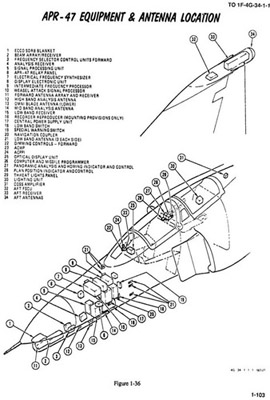- Yes
- No
History
The U.S. military’s first encounter with Soviet surface-to-air missile (SAM) happened in Vietnam. This system, S-75 Dvina (NATO reporting name: SA-2 Guideline), posed a significant threat to U.S. aircraft flying over North Vietnam. The only way to avoid giving the SAM an attack chance is to lower altitude, and this most likely bring aircraft into the anti-aircraft gun’s firing range.
In fact, the United States lost far more aircraft to these air defense systems than to North Vietnamese fighters in the Vietnam War. As a result, equipment and techniques have been devised to counter SAMs during the war.
The Wild Weasel was born out of this process. It was a result of the U.S. Air Force program to develop an aircraft dedicated to SAM detection and destruction. The early Wild Weasel mission was a near-suicide, using only unguided bombs and rockets to strike SAM sites. Technological advances introduced better equipment and tactics to the Wild Weasel, but it is still considered a very dangerous mission.
(YF-4G-43-MC Serial No. 69-7254, the F-4G testbed)
The Wild Weasel program was divided into five phases. There are several Wild Weasel aircraft per program: F-100F Wild Weasel I, F-105G Wild Weasel III, F-4C Wild Weasel IV, and F-4G Wild Weasel V. There was also a Wild Weasel II, which was supposed to utilize the F-4C, but it failed and went straight to Wild Weasel III.
The F-4G’s first and last combat deployment was during Operation Desert Storm. Few years after the Gulf War, the era of the dedicated SEAD aircraft in the U.S. Air Force came to an end. Currently, this mission is performed by more agile and multi-role capable F-16CJ/DJ.
Design
The F-4G Wild Weasel V is a modified F-4E Block 42~45 aircraft for the SEAD mission.
There are some common modifications of the F-4E family like the Agile Falcon leading edge slats. However several elements like TISEO and Pave Tack targeting pod, which is exclusive to some late production aircraft, are not present on F-4G.
Avionics
The F-4G has improved avionics to meet its mission requirements.
AN/APR-47 configuration


The most distinctive feature of the F-4G is the AN/APR-47 radar homing and warning (RHAW) system. The RHAW uses fifty-two antennas placed around fuselage and wings for full 360 degree coverage. This is basically a RWR, but can also compute range to the target in few seconds. Its ranging accuracy was very high: under two miles and two degrees at fifty miles from target, and less than six feet at firing range.
Besides geolocation capability, the APR-47 is also able to identify target radar and shows computed attack envelopes to the crew.
The APR-47 is a system that was ahead of its time, and is often considered better than the F-16’s AN/ASQ-213 HTS. However, there wasn’t enough space to put this bulky system into the F-4E, so the gun was removed from the nose section.
Just like other F-4s, the F-4G carries several ECM pods. There are ECM pod provisions on the inboard wing stations, but rarely used in favor of the fuselage AIM-7 stations.
Armaments
The F-4G is a SEAD aircraft, but retains most of the F-4E’s weapon carriage capability. The AN/APQ-120 radar is still there, so it can engage with enemy aircraft using AIM-7 Sparrow.
However there is no built-in gun, and it cannot use some air-to-ground weapons. Targeting pods are also not an option for the F-4G. Overall, it will be very lethal against SAMs, but only slightly better than the F-4E against other targets.
Specifications
Crew: 2
Length: 63 ft (19.2 m)
Width: 38 ft 5 in (11.7 m)
Height: 16 ft 5 in (5 m)
Weight:
- Empty: 32,961 lb (14,950 kg)
- Operating: 33,500 lb (15,195 kg) (empty weight + 2 crews and engine oil)
- Gross: 46,000 lb (20,865 kg) (operating weight + full internal fuel)
Powerplant: 2× J79-GE-17A/C/E/F/G
Fuel capacity (JP-8):
- Internal: 12,614 lb (5,721 kg)
- External: 9,112 lb (4,133 kg)
Armaments:
- Hardpoints: 9 (4× under wing, 4× fuselage, 1× centerline)
- Air-to-air missiles:
- 4× AIM-9L/M Sidewinder
- 4× AIM-7M Sparrow
- Air-to-ground missiles:
- 4× AGM-45 Shrike
- 6× AGM-65B/D Maverick
- 2× AGM-65G Maverick
- 4× AGM-78C/D Standard ARM
- 4× AGM-88 HARM
- Guided bombs: 4× GBU-8
- Unguided bombs:
- 24× Mk 82
- 3× Mk 84
- 4× Mk 84 AIR
- 12× Mk 20 Rockeye
- 14× CBU-87
- Unguided rockets: 70× FFAR (10× LAU-131)
- Gun pods:
- GPU-5/A
- 3× SUU-23/A
Avionics:
- Radar: AN/APQ-120
- RWR: AN/APR-47
Countermeasures:
- Chaff/Flare: 2× AN/ALE-40 (60 countermeasures + 30 large caliber countermeasures)
- ECM Pods:
- AN/ALQ-119
- AN/ALQ-131
- AN/ALQ-176
- AN/ALQ-184
Sources
- T.O. 1F-4E-1 Flight Manual USAF Series F-4E Aircraft (1 April 1990)
- T.O. 1F-4G-1 Flight Manual USAF Series F-4G Aircraft (15 June 1978)
- T.O. 1F-4G-1 Flight Manual USAF Series F-4G Aircraft (3 Nov 1993)
- McDonnell Douglas F-4G Wild Weasel from National Museum of the United States Air Force
- F-4 Phantom II Wild Weasel Units in Combat by Peter E. Davies
- Magnum! The Wild Weasels in Desert Storm: The Elimination of Iraq’s Air Defence by Brick Eisel and James A. Schreiner
- Former Electronic Warfare Officer explains why the F-4G was the best Wild Weasel aircraft USAF Has ever Had - The Aviation Geek Club
- Texas Instruments (Raytheon) AGM-88 HARM








